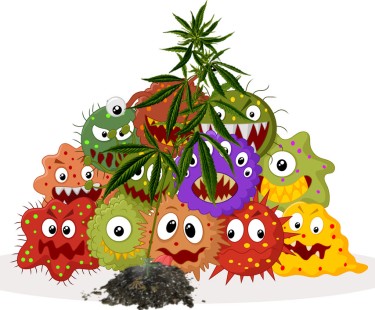Business
The Microbes Behind the Magic – The Role of Microorganisms in Growing Top-Shelf Cannabis Plants

What are microorangisms and how do they help great weed?
As a cannabis connoisseur and cultivator with decades of experience, I’ve come to understand the importance of microorganisms in the cultivation process. From bacteria and fungi to tiny nematodes and mites, these microorganisms play a crucial role in maintaining healthy and productive cannabis plants.
But let’s be real, when most people think about cannabis cultivation, they’re focused on the buds and not the bugs.
But trust me, ignoring these microorganisms is a huge mistake. In this article, we’ll dive into the role of microorganisms in cannabis cultivation, and why paying attention to the unseen inhabitants of your grow operation can lead to bigger buds, better flavor, and overall better quality. So, don’t be a dummy, pay attention to the microorganisms in your cannabis cultivation process.
The Basics of Microorganisms in Soil
When it comes to cannabis cultivation, it’s all about the dirt, baby. And when it comes to dirt, it’s all about the microorganisms. These tiny organisms play a massive role in keeping your plants healthy and happy. First off, let’s break down the different types of microorganisms found in soil. You’ve got your bacteria, fungi, nematodes, and mites, just to name a few. Each of these little critters plays a unique role in the soil ecosystem.
Bacteria, for example, are responsible for breaking down organic matter and converting it into usable nutrients for plants. Fungi, on the other hand, form symbiotic relationships with plant roots, helping to absorb nutrients and protect against pathogens. And nematodes, well they’re the unsung heroes of soil health, eating harmful pathogens and aerating the soil.
All these microorganisms work together to create a delicate balance of nutrient cycling and soil health. Without them, your plants would be left without the necessary resources to thrive. As the great cannabis cultivator, Tom Lauerman, once said, “microorganisms are the true workhorses of the soil, breaking down organic matter and making it available to plants.”
So, if you want to be a top-notch grower, it’s essential to understand the role of microorganisms in your soil ecosystem. By maintaining a healthy balance of microorganisms, you’ll be on your way to bigger buds, better flavor, and overall better quality. Don’t neglect the unseen inhabitants of your grow operation, they’re the key to success.
The Benefits of Beneficial Microorganisms for Cannabis Cultivation
When it comes to cannabis cultivation, beneficial microorganisms are the secret weapon for bigger buds and better yields. Let’s begin with “mycorrhizal fungi.”
These little guys form symbiotic relationships with plant roots, helping to absorb nutrients and protect against pathogens. In fact, according to Dr. Elaine Ingham, “mycorrhizal fungi can increase the root surface area of a plant by up to 1000 times, allowing plants to absorb more nutrients and water.”
Next, you’ve got bacteria. These microorganisms are responsible for breaking down organic matter and converting it into usable nutrients for plants. They also help to suppress harmful pathogens and improve soil structure. Without beneficial bacteria, your plants would be left without the necessary resources to thrive.
Other beneficial microorganisms, like trichoderma and protozoa, also play a crucial role in cannabis cultivation. Trichoderma helps to protect plants from pathogens and improve nutrient uptake, while protozoa help to control harmful nematodes and other pests.
In short, beneficial microorganisms are essential for healthy cannabis plants and bountiful yields. By understanding and utilizing the power of these microorganisms, cultivators can take their growing game to the next level. As the cannabis cultivator and researcher, Dr. Jeff Lowenfels, states “The secret to successful gardening is healthy soil and the life that exists in it.”
Methods for introducing beneficial microorganisms into the soil:
- Use a high-quality compost or worm castings to introduce a diverse population of microorganisms into your soil.
- Incorporate mycorrhizal fungi into your soil through the use of mycorrhizal inoculants.
- Use a soil drench or foliar spray of beneficial bacteria to introduce them directly to the plant’s root zone.
Tips for maintaining a healthy soil ecosystem:
- Avoid the use of chemical pesticides and fertilizers, as they can disrupt the balance of microorganisms in the soil.
- Keep an eye on pH levels and adjust as needed to promote the growth of beneficial microorganisms.
- Incorporate crop rotation and cover crops to promote soil health and biodiversity.
Best practices for using microorganisms in cannabis cultivation:
- Test your soil regularly to monitor the levels of microorganisms and adjust your cultivation practices accordingly.
- Pay attention to the microclimate in your grow room, as temperature and humidity can affect the survival and growth of microorganisms.
- Use a diverse range of microorganisms to promote a healthy and balanced soil ecosystem.
Sticky Bottom line
Microorganisms play a crucial role in cannabis cultivation. From nutrient cycling and soil health, to plant growth and yields, these tiny organisms are the unsung heroes of the cannabis growing world. By understanding and utilizing the power of microorganisms, cultivators can achieve bigger buds, better flavor, and overall better quality.
But it’s not just about the end result, it’s also about the journey. Incorporating microorganisms into your cannabis growing operation is not only about leveling up your cultivation game, but also about taking a holistic approach to growing. It’s about treating your plants, soil and environment with the respect they deserve. It’s about understanding the delicate balance of nature and working in harmony with it.
So, the question is: are you ready to take your cannabis cultivation to the next level? Are you ready to embrace the unseen inhabitants of your grow operation and unlock the full potential of your plants? The choice is yours. Remember, healthy soil equals healthy plants, and microorganisms are the key to healthy soil. So, let’s give them the attention they deserve!